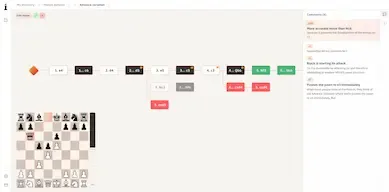
A new approach to using a chess repertoire
When we think of chess repertoires, we often see them as tools to help us memorize opening lines or even mid-game strategies. ChessFlare takes this a step further by allowing you to actively build and deepen your chess knowledge. With its unique system of move trees and in-depth comments, ChessFlare grows alongside your repertoire, helping you not just remember, but truly understand the game. Writing down your insights is an incredibly effective way to internalize and improve your understanding of chess. ChessFlare’s easy revision and editing features allow you to revisit and refine your previous knowledge, building a stronger, more critical foundation.
For a practical example, start simple: download a PGN of the Italian Game into ChessFlare. Comment on the purpose of each move, study the lines that led to your defeat, analyze where things went wrong, and incorporate those insights into your repertoire. This process helps you transform your losses into learning opportunities and grow as a player.
Trial and Error: Mastering Chess Through Practice
In chess, progress often comes from trial and error. ChessFlare encourages you to experiment with different lines, explore new possibilities, and, yes, make mistakes. Every failed attempt is a learning opportunity, and by engaging with your repertoire in this way, you can turn failures into stepping stones toward success. Don’t be afraid to lose or experiment—ChessFlare’s intuitive interface and flexible move trees allow you to test strategies, adapt on the fly, and discover what works best for your style of play.
Critique and Improve: Elevate Your Chess Repertoire
Self-criticism is an essential part of growth in any discipline, and chess is no exception. ChessFlare empowers you to critically evaluate your repertoire, challenging outdated ideas or weak lines that no longer hold up against stronger opponents. With its seamless revision and note-taking tools, you can keep your repertoire up-to-date, making sure it evolves as you do. Regularly critiquing and upgrading your knowledge turns ChessFlare into a dynamic tool that evolves with you, helping you not only improve your performance but also sharpen your understanding of the game.
Frequently Asked Questions
How to memorize chess openings?
How to play chess for beginners?
How to play better chess?
How to win chess?
What are good chess openings?
How to memorize chess openings?
How to be good at chess?

